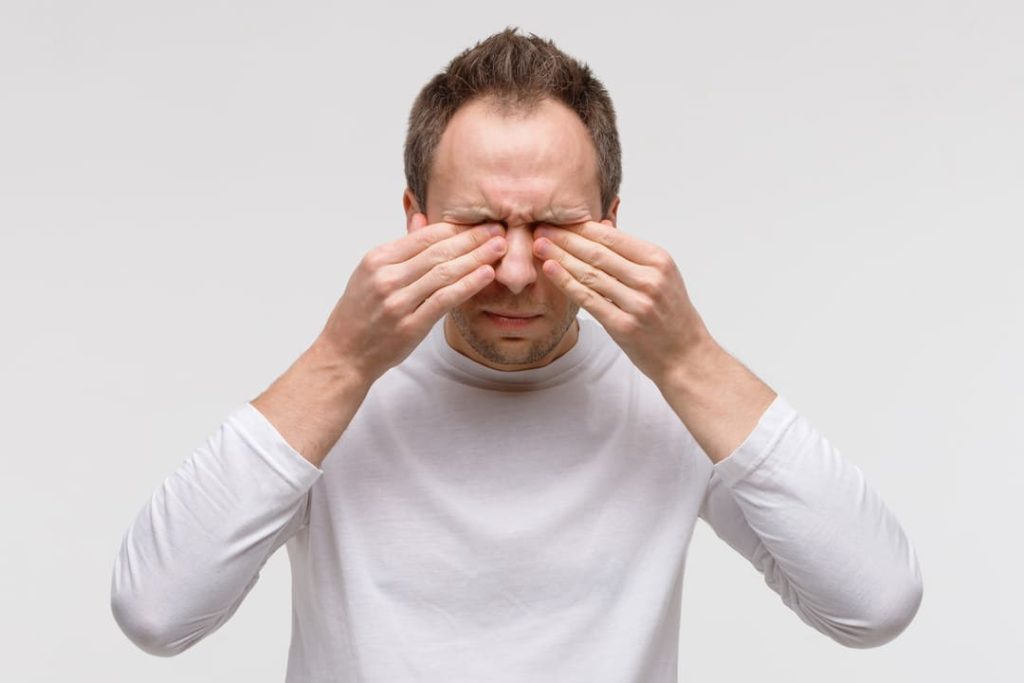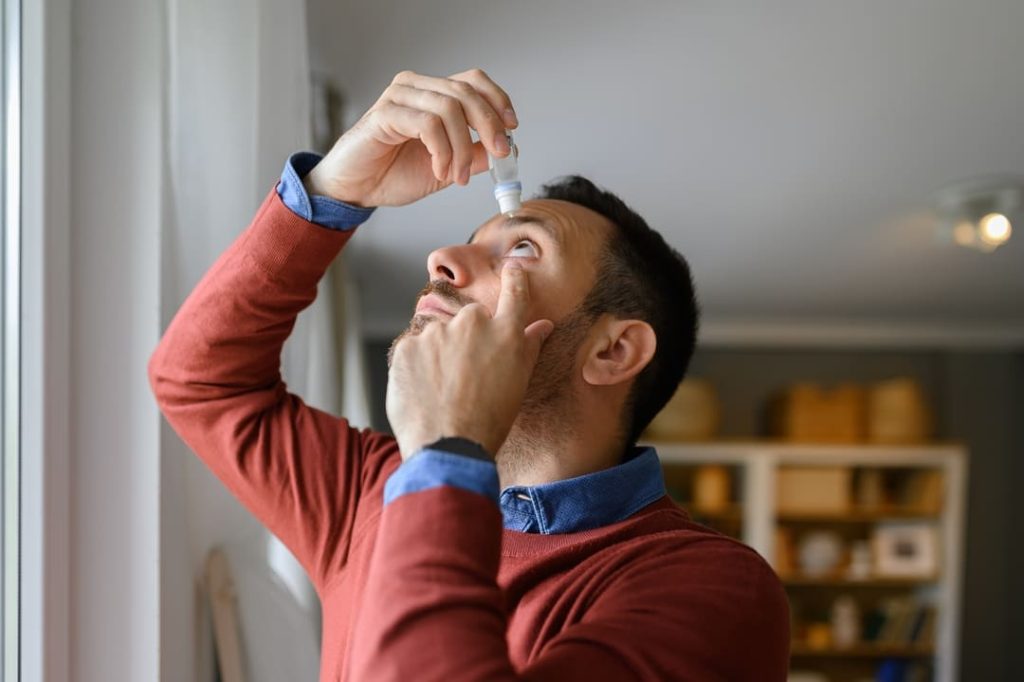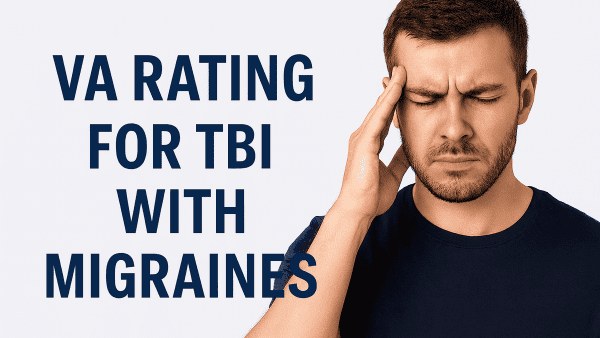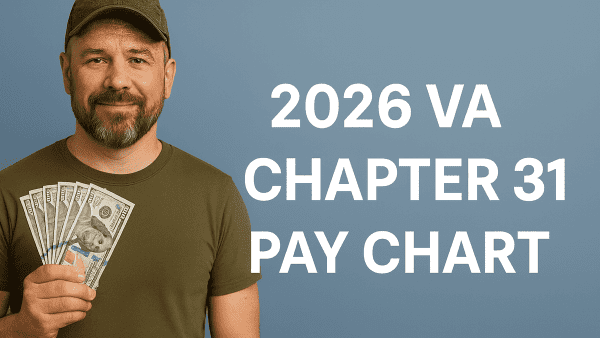Looking for Expert-Level VA Claim Answers?📱Call Us Now! 737-295-2226
Dry eye syndrome is more than a nuisance; it’s an uncomfortable condition that causes itchiness, redness, and blurred vision.
If you’re a veteran suffering from dry eyes, it’s important you understand what you’re entitled to.
This post will break down dry eye syndrome in veterans, including how to service connect your condition, how to file a VA claim, VA ratings for eye conditions, and much more.
Do you qualify for VA disability for dry eye syndrome?
Let’s find out.
Summary of Key Points
-
VA disability for dry eye syndrome can be rated at 10%, 20%, 40%, and 60%.
-
The VA rating chart for dry eye syndrome is found under the Schedule of Ratings for Diseases of the Eye.
-
You can file for VA disability for dry eye syndrome online, by mail, or in person.
Table of Contents
Dry Eye Syndrome in Veterans

Dry eye disease generally occurs when your eyes don’t produce enough tears or your tears evaporate too quickly.
According to a 2021 study, veterans with Gulf War illness (GWI) had more severe dry eye symptoms than those who served in the Gulf War but didn’t meet the criteria for GWI.
Other causes of dry eye syndrome in veterans include exposure to wind, dust, or dry weather.
You can treat dry eye syndrome with over-the-counter treatments, but sometimes, people need more aggressive treatment methods.
Symptoms
Symptoms of dry eye syndrome include, but are not limited to:
- Sensitivity to light
- A burning or stinging sensation in your eyes
- Eye redness
- Watery eyes
- Blurred vision or eye fatigue
Dry eye syndrome can affect one or both eyes, so it’s common for you to experience discomfort in only one eye.

VA Disability for Dry Eye Syndrome
The VA eye conditions under § 4.79 Schedule of ratings— diseases of the eye. Dry eye VA disability ratings range from 10%-60%, with breaks at 20% and 40%.
Your VA disability for dry eye syndrome will depend on the number of documented incapacitating episodes you have in a year that require treatment visits.
How to Service-Connect Dry Eye Syndrome
To receive VA disability for dry eye syndrome, you must prove service connection. To do this, you need:
- A current medical diagnosis of dry eye syndrome
- An in-service event, illness, injury, or aggravation
- A medical nexus, or link, between your medical condition and military service
3 Things the VA Needs to Prove Your Service-Connected Disability (Video)
How to File for Dry Eye Syndrome VA Disability
You have several options when filing for VA disability for dry eyes. While the easiest way to file a VA claim is online, you can also:
- Download, print, and complete VA Form 21-526EZ, then mail your application to:
Department of Veterans Affairs
Claims Intake Center
PO Box 4444
Janesville, WI 53547-4444
- Bring your completed application to a VA regional office near you.
- Fax your completed application to:
844-531-7818 (Inside the U.S)
248-524-4260 (Outside the U.S.)
Regardless of your method of choice, ensure you completely fill out your VA claim application, avoiding potential delays in the process.
See Also: How to File a VA Claim Online (17-Step Tutorial)
Evidence Needed to Support Your VA Claim
To help support your VA claim for dry eye VA disability, it’s recommended you include the following evidence. While the VA doesn’t require you to submit evidence, it can help them determine whether you require a claim exam to help them better understand your condition.
- VA medical records and hospital records
- Private medical records and hospital reports
- Supporting statements
VA and private medical records and hospital reports can help show records of your claimed illnesses or injuries or show that your rated disability has worsened.
Supporting statements come from:
- Family members
- Friends
- Clergy members
- Law enforcement personnel
- Fellow service members
How the VA Rates Dry Eye Syndrome
Dry eye syndrome is one of those tricky conditions that doesn’t have a specific diagnostic code. However, as an unlisted condition, it can be rated under a closely related disease or injury affecting the same body part with similar symptoms.
For example, any condition that affects the production of tears (disorders of the lacrimal apparatus) is rated under code 6025. If one eye is affected, it is rated 10%. If both eyes are affected, the condition is rated 20%.
VA Rating Chart for Eye Conditions Affecting the Production of Tears
| DC 6025, Disorders of the lacrimal apparatus (epiphora, dacryocystitis, etc.) | VA Rating |
| Bilateral | 20% |
| Unilateral | 10% |
VA Disability Rating Chart for Eye Conditions
| General Rating Formula for Diseases of the Eye: | VA Rating |
| Evaluate on the basis of either visual impairment due to the particular condition or on incapacitating episodes, whichever results in a higher evaluation | |
| With documented incapacitating episodes requiring 7 or more treatment visits for an eye condition during the past 12 months | 60% |
| With documented incapacitating episodes requiring at least 5 but less than 7 treatment visits for an eye condition during the past 12 months | 40% |
| With documented incapacitating episodes requiring at least 3 but less than 5 treatment visits for an eye condition during the past 12 months | 20% |
| With documented incapacitating episodes requiring at least 1 but less than 3 treatment visits for an eye condition during the past 12 months | 10% |
| Note (1): For the purposes of evaluation under 38 CFR 4.79, an incapacitating episode is an eye condition severe enough to require a clinic visit to a provider specifically for treatment purposes | |
| Note (2): Examples of treatment may include but are not limited to: Systemic immunosuppressants or biologic agents; intravitreal or periocular injections; laser treatments; or other surgical interventions | |
| Note (3): For the purposes of evaluating visual impairment due to the particular condition, refer to 38 CFR 4.75-4.78 and to § 4.79, diagnostic codes 6061-6091 |
Additional Resource: Insider’s Guide to VA Eye Disability Ratings
Check out our Complete Insider’s Guide to Eye Disability Ratings for more information about receiving disability for eye conditions.
Conclusion
Dry eye syndrome may seem minor, but for many veterans, it’s a persistent condition that disrupts daily life and deserves recognition. If your service contributed to this issue, don’t overlook your right to VA disability compensation. With the right evidence and support, you can file a strong claim and get the benefits you deserve.
Deserve a Higher VA Rating? WE GOT YOUR SIX!
- VA Claims Insider is the #1 most trusted name in VA disability claims.
- Work directly with a VA claims coach who can educate you to VA claim victory.
- 25,000+ disabled veterans have served in our membership programs since 2016.
- 30% average rating increase for veterans who complete our #1-rated Elite program.
- 4.7/5.0 average rating out of 5,500+ total reviews; over 4,500 5-star reviews.
FAQs | Frequently Asked Questions
How do you qualify for dry eye VA disability?
To qualify for dry eye VA disability, you must prove your military service caused your condition. In addition, it’s recommended you obtain medical evidence to help strengthen your case when submitting your VA claim.
Is dry eye syndrome a presumptive condition?
No, dry eye syndrome isn’t a presumptive condition. However, you may still qualify for a dry eye syndrome VA rating if you can prove your military service caused your condition.
Is there a bilateral dry eye syndrome VA rating?
If you have a condition affecting the production of tears in both eyes, you may qualify for a 20% VA rating.
Author

Kelly Olone
Kelly Olone is a military spouse who earned her degree in Psychology from Florida International University. After working in the non-profit sector for several years, she turned to her passion for writing. She aims to contribute to a better understanding of the valuable benefits that veterans deserve. As a mom, Kelly navigates the delicate balance between deadlines and bedtime stories with finesse.



